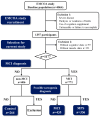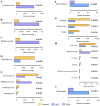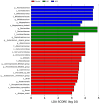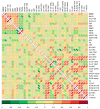The Link Between Oxysterols and Gut Microbiota in the Co-Dysfunction of Cognition and Muscle
- PMID: 40219034
- PMCID: PMC11990608
- DOI: 10.3390/nu17071277
The Link Between Oxysterols and Gut Microbiota in the Co-Dysfunction of Cognition and Muscle
Abstract
Background/Objectives: Alterations of oxysterols and gut microbiota have been recognized as indicators affecting mild cognitive impairment (MCI) and sarcopenia, respectively, whereas their association with co-dysfunction has not been investigated. Methods: In this study, a total of 1035 individuals were divided into Control (n = 264), MCI (n = 435), and MCI with possible sarcopenia (MPS, n = 336) groups. Cognition and muscle indexes, serum oxysterols, and gut microbiota were measured. Spearman's rank coefficients were calculated to determine their correlations. Results: Performances of global and multidimensional cognitive tests was successively worse in the Control, MCI, and MPS groups. Longer duration of five-time chair stand test, lower 6-meter walk speed, and handgrip strength were observed in the MPS group, along with increased 27-hydroxycholesterol (27-OHC) and 5α,6α-epoxycholesterol and decreased 5α-Cholest-8(14)-ene-3β,15α-diol (15-HC). Higher concentrations of amyloid precursor protein (APP), neurofilament, and C-terminal agrin fragment (CAF) were discovered in the MCI and MPS groups. The α-diversity of gut microbiota in the MCI and MPS group was remarkably decreased, followed by a shifted abundance of microbial taxa, such as Alistipes and Rikenellaceae. Multiple significant correlations were found between cognition and muscle indexes and with oxysterols. Conclusions: Our study indicates that oxysterols and gut microbiota are prominently involved in the co-dysfunction of cognition and muscle.
Keywords: comorbidity; gut microbiota; mild cognitive impairment; muscle function; oxysterols.
Conflict of interest statement
The authors declare no conflicts of interest.
Figures










Similar articles
-
Linking oxysterols and different stages of mild cognitive impairment: insights from gut metabolites and N6-methyladenosine.Alzheimers Res Ther. 2025 May 13;17(1):102. doi: 10.1186/s13195-025-01743-5. Alzheimers Res Ther. 2025. PMID: 40361183 Free PMC article.
-
A panel of altered blood oxysterols in patients with mild cognitive impairment: A novel combined diagnostic marker.Pharmacol Res. 2025 Mar;213:107661. doi: 10.1016/j.phrs.2025.107661. Epub 2025 Feb 19. Pharmacol Res. 2025. PMID: 39984005
-
Relationship between oxysterols and mild cognitive impairment in the elderly: a case-control study.Lipids Health Dis. 2016 Oct 10;15(1):177. doi: 10.1186/s12944-016-0344-y. Lipids Health Dis. 2016. PMID: 27724967 Free PMC article.
-
Association of Gut Microbiome with Muscle Mass, Muscle Strength, and Muscle Performance in Older Adults: A Systematic Review.Int J Environ Res Public Health. 2024 Sep 20;21(9):1246. doi: 10.3390/ijerph21091246. Int J Environ Res Public Health. 2024. PMID: 39338129 Free PMC article.
-
Gut Microbiota, Muscle Mass and Function in Aging: A Focus on Physical Frailty and Sarcopenia.Nutrients. 2019 Jul 17;11(7):1633. doi: 10.3390/nu11071633. Nutrients. 2019. PMID: 31319564 Free PMC article. Review.
References
-
- Chen X., Han P., Yu X., Zhang Y., Song P., Liu Y., Jiang Z., Tao Z., Shen S., Wu Y., et al. Relationships between sarcopenia, depressive symptoms, and mild cognitive impairment in Chinese community-dwelling older adults. J. Affect. Disord. 2021;286:71–77. - PubMed
-
- Amini N., Ibn Hach M., Lapauw L., Dupont J., Vercauteren L., Verschueren S., Tournoy J., Gielen E. Meta-analysis on the interrelationship between sarcopenia and mild cognitive impairment, Alzheimer’s disease and other forms of dementia. J. Cachexia Sarcopenia Muscle. 2024;15:1240–1253. doi: 10.1002/jcsm.13485. - DOI - PMC - PubMed
MeSH terms
Substances
Grants and funding
LinkOut - more resources
Full Text Sources
Medical

